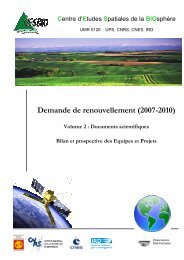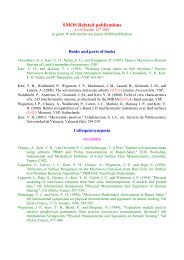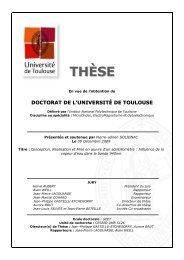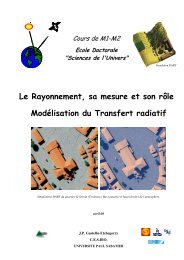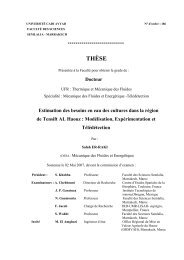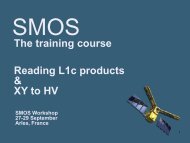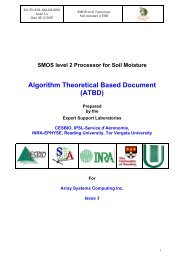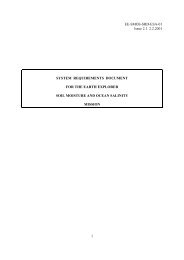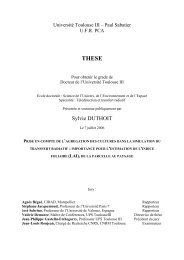Algorithm Theoretical Based Document (ATBD) - CESBIO
Algorithm Theoretical Based Document (ATBD) - CESBIO
Algorithm Theoretical Based Document (ATBD) - CESBIO
You also want an ePaper? Increase the reach of your titles
YUMPU automatically turns print PDFs into web optimized ePapers that Google loves.
SO-TN-ESL-SM-GS-0001<br />
Issue 1.a<br />
Date: 31/08/2006<br />
SMOS level 2 processor<br />
Soil moisture <strong>ATBD</strong><br />
c L = function (canopy type) Eq 31<br />
LWC = function (canopy type, litter moisture content (%))<br />
Eq 32a<br />
The value of c L has been estimated from microwave measurements acquired over a fallow during the SMOSREX<br />
experiment [50]. τ L was computed as a function of the retrieved value of τ P minus the estimated value of the<br />
standing vegetation optical depth (τ Sp ), when there was no intercepted water. There was a clear correlation between<br />
computed values of τ L and LWC (R 2 = 0.61, 10 measurement values) and the estimated value was c L = 0.24. This<br />
value is about twice that of b P, confirming possibly higher attenuation properties for litter than for standing canopy.<br />
The average value of LWC in absence of rainfall over the fallow was 0.5 kg/m 2 .<br />
Preliminary default value of c L will thus be set to c L = 0.24.<br />
The amount of water included in the litter layer (LWC, kg/m 2 ) will be computed as a function of its moisture<br />
content ( Mg_L kg/kg), which is the ratio of the litter water content (kg) to the total litter weight (kg)) and of the<br />
litter dry biomass (B S _L, kg/m 2 ) as follows:<br />
LWC = [Mg_L / (1-Mg_L)] B S _L<br />
Eq 32b<br />
A default value of the litter dry biomass estimated from SMOSREX data (fallow) is B S _L = 0.3 kg/m 2 .<br />
Preliminary results obtained during the SMOSREX experiment indicated that Mg_L could be related to the soil<br />
moisture content (SM) following an approximate linear relationship:<br />
Mg_L = a_L . SM + b_L<br />
with 0 ≤ Mg_L ≤ 0.8<br />
Eq 32c<br />
Note that we will consider that the litter moisture content (Mg_L, kg/kg) is lower than 0.8. Thus when computing<br />
Mg_L , values exceeding 0.8 will be set to 0.8 (Mg_L=0.8) and values lower than zero will be set to zero (Mg_L=0).<br />
Results obtained from SMOSREX will be used to define default parameters a_L = 2.33 and b_L = 0.<br />
(corresponding to a litter moisture content of 70% for a soil moisture SM = 0.3 m 3 /m 3 ).<br />
In summary, the optical depth of the litter layer τ L will be computed as a function of the following vegetation<br />
parameters: c L , a_L, b_L and B S _L and of soil moisture (SM). The four vegetation parameters (c L , a_L, b_L and<br />
B S _L) will be assumed to depend on the vegetation type only and will be provided a priori in a table as a function<br />
of the vegetation type index. Default values of these parameters were estimated from the SMOSREX experiment<br />
(fallow vegetation).<br />
3) τ IP is the optical depth which parameterizes the effect of intercepted water by the standing vegetation<br />
canopy, due to rainfall or dew events. Results obtained over a senescent wheat canopy showed that for moderate<br />
amount of intercepted water (less than 1.5 mm intercepted water), the L-band measurements remained very<br />
sensitive to soil moisture, and simultaneous retrievals of both soil moisture and optical depth were possible (socalled<br />
2-P for 2-Parameter retrieval approach) [52]. Therefore, it is likely that during dew events, during which the<br />
amount of intercepted water is relatively small (~ 1 mm), 2-P retrievals are possible. However, recent and<br />
preliminary results [50] obtained over a fallow (SMOSREX experiment) showed that the effects of intercepted<br />
water might be very significant over some vegetation canopies. The optical depth may increase by a factor of two or<br />
more after rainfall events. The water can be intercepted by the green vegetation material (the water is mainly on the<br />
surface of the vegetation elements) or by senescent or dead standing vegetation elements (the water is mainly<br />
adsorbed by the dead vegetation tissue). Over some natural vegetation covers, this fraction of dead or senescent<br />
vegetation elements may be significant.<br />
An attempt to parameterize τ IP would require estimations of the interception reservoir (mm) and of the fraction of<br />
intercepted water. However, estimating the fraction of intercepted water which depends on the intensity of the<br />
rainfall events and evaporation fluxes would be very difficult.<br />
Rather than attempting to parameterize the interception events, we propose to use an index flagging events during<br />
which interception effects are very significant (and during which it is very likely that soil moisture cannot be<br />
retrieved). Preliminary results [50] showed that one of the best indices that can be used to flag interception at local<br />
scale 4 is the polarization ratio PR = (TB V - TB H ) / (TB V + TB H ) at rather large incidence angle (θ ≈ 50°).<br />
Significant interception events are associated to low values of PR. We propose setting a threshold so that low PR<br />
4 At SMOS scale the approach will have to be validated<br />
.<br />
38





